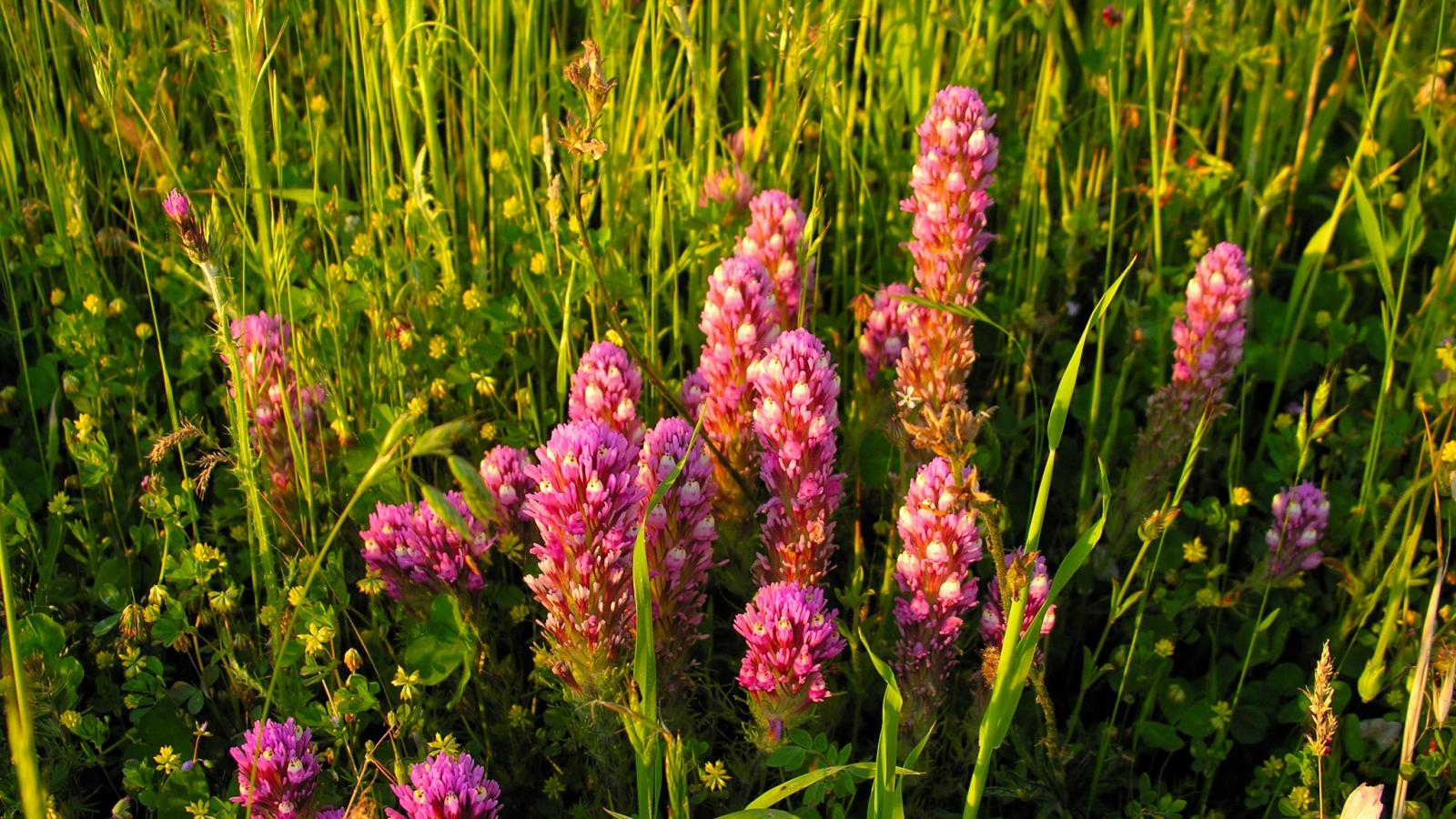Removing invasive plants and weeds is a large part of the restoration work that takes place in our preserves. This can be challenging, since some invasive species look similar to California natives. Help us protect native plants: become a community scientist and record your observations in the free iNaturalist app. This information helps us monitor the open space lands and identify areas of concern.
Please do not pull any plants on Midpen lands; we follow a strategic plan when dealing with invasive species and removing plants can actually spread the growth of unwanted species. Learn more about how Midpen uses Integrated Pest Management to manage invasive species.
Native plant and their nonnative look-alikes. Can you tell the difference?
Native - California blackberry (Rubus ursinus)
Image
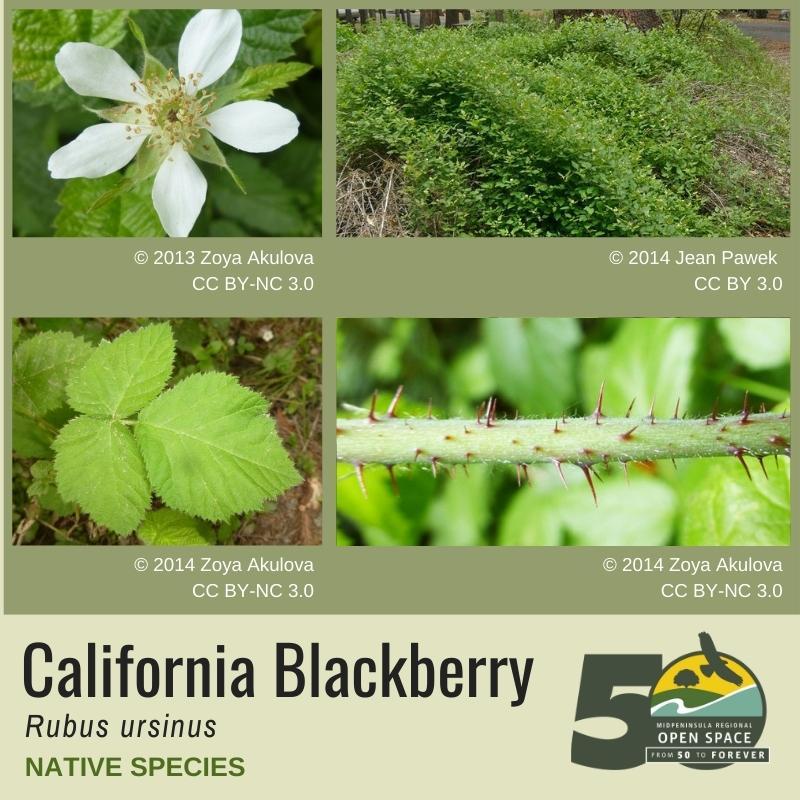
- A deciduous vine or shrub native to California
- Found in canyon, coastal and stream bank habitats
- Due to its ability to grow in infertile soils, valuable for preventing soil erosion at disturbed sites.
- Grows upright to 6 feet tall and sprawls to 6 feet wide with thorny stems and serrated leaves that typically grow in groups of three leaflets
- Blooms February to May with white, fragrant flowers
- Provides food, critical habitat and cover for a variety of wildlife species, including birds, deer, coyotes, skunks, foxes, squirrels and raccoons
Nonnative - Himalayan blackberry (Rubus armeniacus)
Image
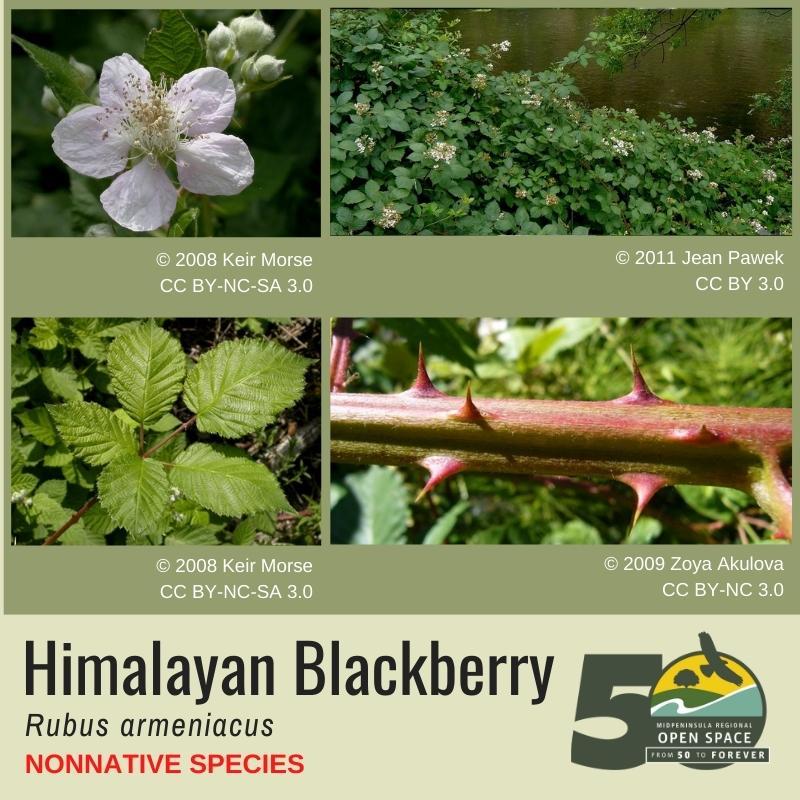
- Invasive, nonnative, evergreen shrub from Eurasia that was introduced for fruit production
- Found in many habitats, but especially in wetland and riparian communities
- Grows in thickets up to 13 feet high with sprawling thorny stems up to 40 feet long; thorns are notably large (often more than 3/4 of an inch); serrated leaves typically grow in groups of five leaflets
- Blooms April through August with white to light pink flowers
- Supports many pollinators, including native bees, bumble bees and hummingbirds
- It rapidly displaces native plant species by producing a dense canopy that limits sunlight for understory plants and plant germination
- The dense thickets are often impassable by larger animals and can block them from water sources
January 2022
Native - Toyon (Heteromeles arbutifolia)
Image
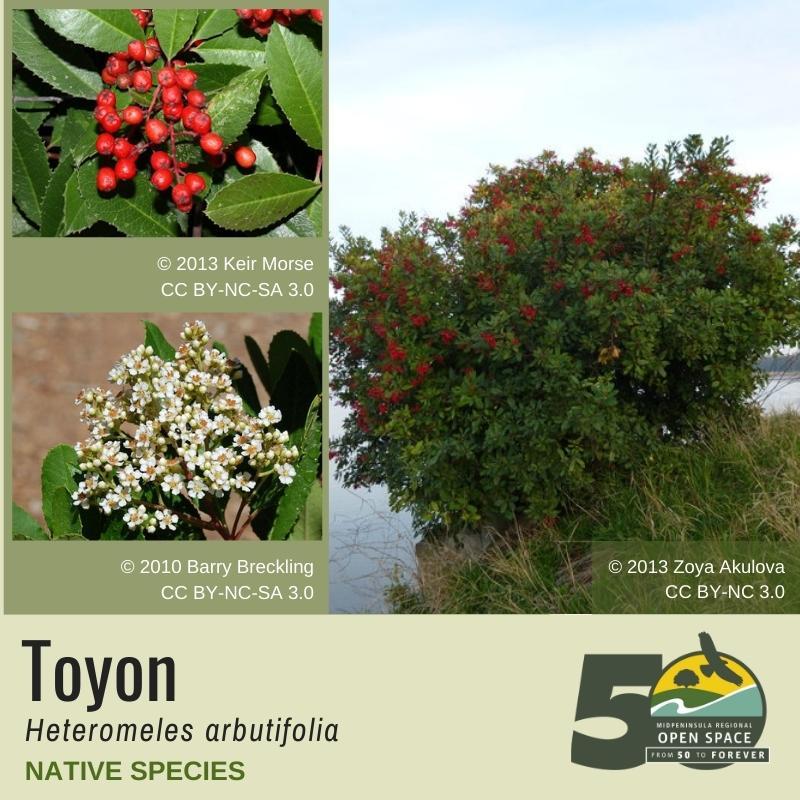
- A perennial woody shrub native to California that is also known as "Christmas berry" and "California holly"
- Found in chaparral plant communities in canyons and on slopes
- Grows up to 30 feet tall with thick, sharply toothed, leathery textured, evergreen leaves
- Blooms with dense bunches of small white flowers from June to August
- Known for its bright red berries that are toxic to humans because they contain a cyanide compound
- Flowers attract pollinators like native bees and hummingbirds and the berries attract many species of birds, including California quail and band-tailed pigeon, as well as raccoons.
- Toyon is a known host of the oomycete pathogen Phytophthora ramorum, which causes the disease sudden oak death (SOD), and the insect-transmitted bacterium Xylella fastidiosa, which causes numerous plant diseases with varying symptoms, including leaf scorching and wilting, as well as stunted growth of leaves, fruits and overall plant height.
Nonnative - Silverleaf Cotoneaster (Cotoneaster pannosus)
Image
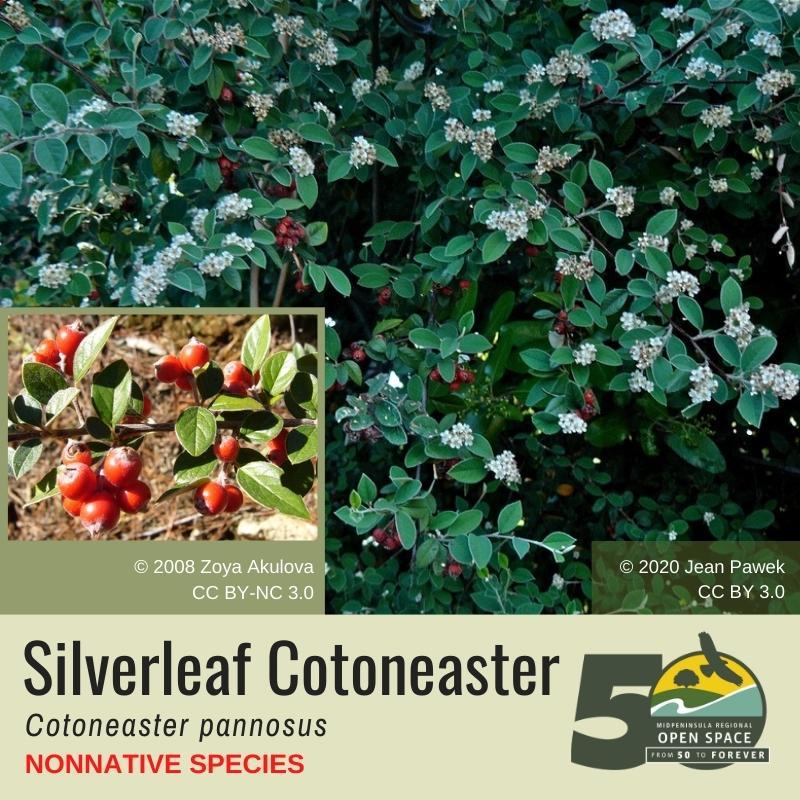
- Invasive, nonnative, perennial, woody shrub from south central China
- Found in ornamental landscaping, disturbed places, especially near residential sites, and undisturbed coastal scrubs, grasslands and forests.
- Grows up to 6 feet tall in a upright form evergreen leaves
- Blooms May through July with small clusters of white flowers
- Produces thousands of bright red berries in small clusters
- Spreads through seed distribution by birds and small mammals, as well as by people who plant the species
- A common pest to the plant is the glassy-winged sharpshooter (Homalodisca vitripennis) that often transmits the bacterium Xylella fastidiosa from one plant to another
Native - Common Rush (Juncus patens)
Image
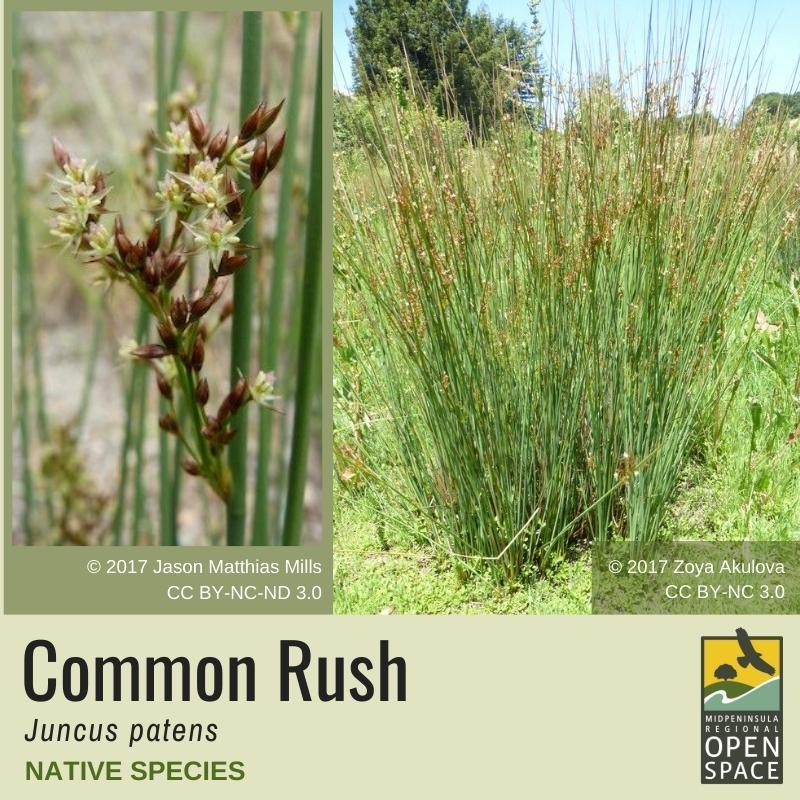
- A perennial grass-like herb native to California that is also known as "spreading rush"
- Found in wetland, riparian and other plant communities in moist areas such as stream banks, seeps, creeks and marshy places
- Grows up to three feet tall in an evergreen fountain with thin, slightly grooved blue, gray or green stems
- Fruits June through October with red-brown flowers
Nonnative - Spanish Broom (Spartium junceum)
Image
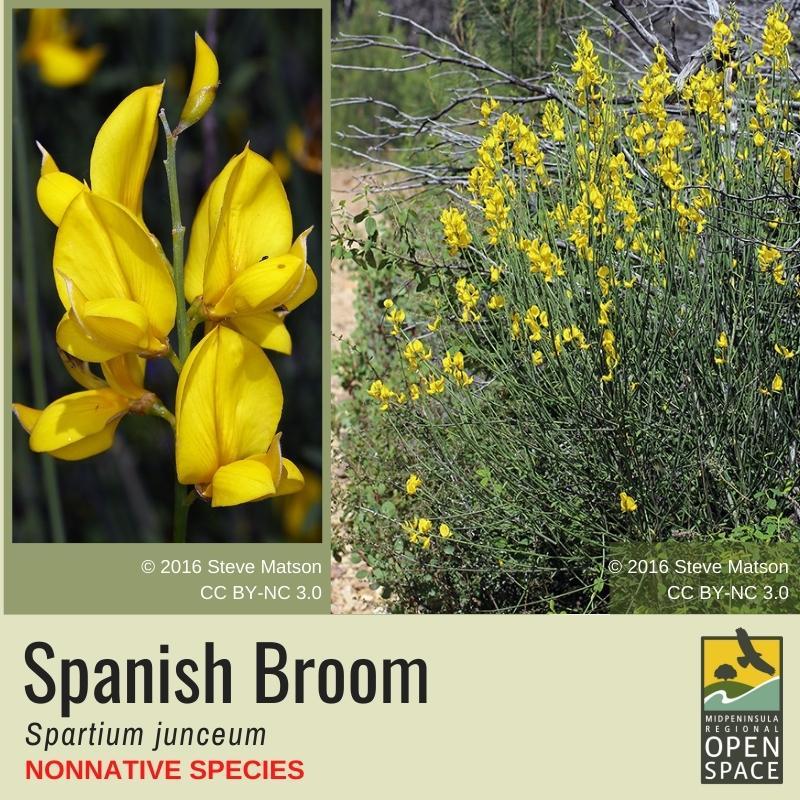
- Invasive, nonnative, perennial shrub from the southern Mediterranean region of Europe
- Grows up to 15 feet tall in a upright form with cylindrical green stems that become woody with maturity
- Blooms April through June with light yellow, peas-like flowers
- Rapidly colonizes disturbed habitats and develops thick shrub communities that outcompete native chaparral species
- Poor forage for wildlife and a fire hazard during the dry season
Native - Vanilla Grass (Anthoxanthum occidentale)
Image
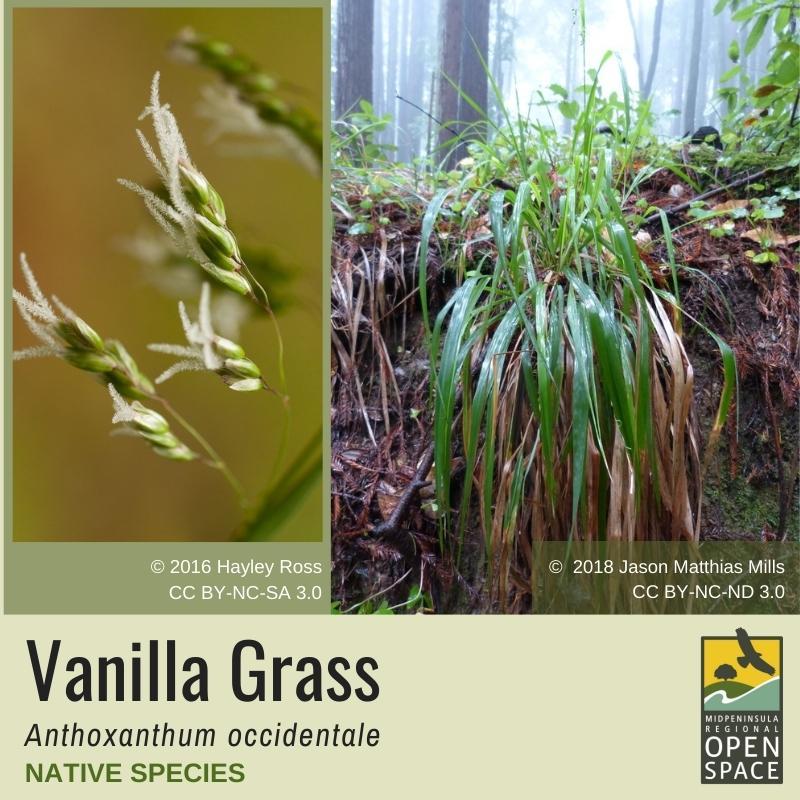
- A perennial grass-like herb native to California that is also known as California sweet grass
- Found in redwood, mixed evergreen and closed-cone pine forests
- Grows up to two feet tall with green, erect, grass-like leaves and yellow spikelets
- Blooms from January to July
- Host plant for a number of species of moths and butterflies
Nonnative - Slender False Brome (Brachypodium sylvaticum)
Image
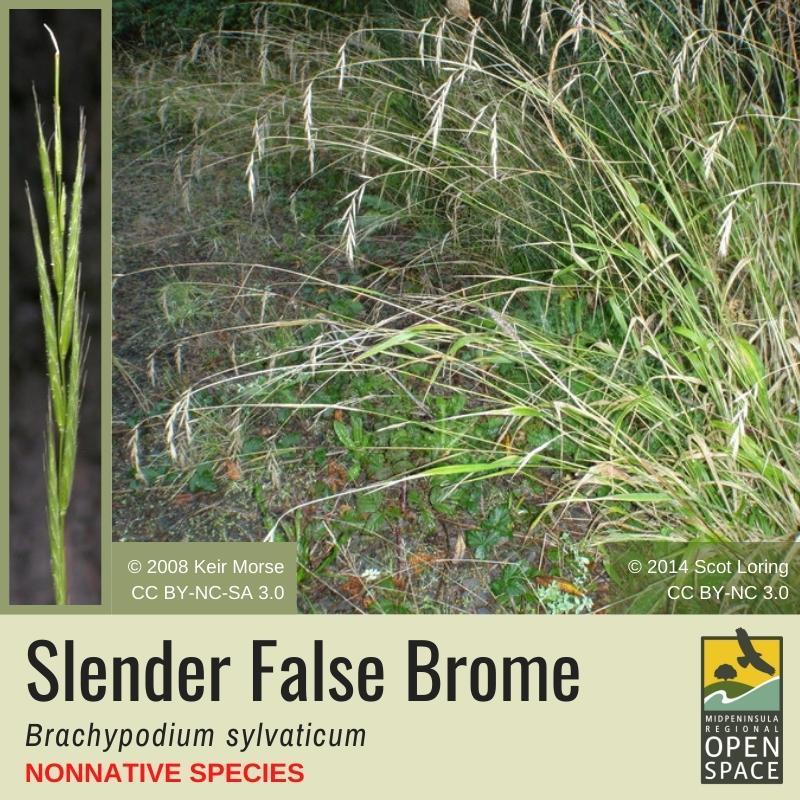
- Invasive, nonnative, perennial bunch grass from Europe, Asia and North Africa
- Grows up to 3 feet tall with broad drooping blades; it remains bright green through fall into winter and has straight white hairs along the margin of the leaf and along the sheath
- Blooms from June to August with drooping spikelet flowers
- Capable of achieving over 90% ground cover, it can inhibit the growth of tree seedlings and replace native vegetation
- Found primarily in Oregon, it has been spreading into southern Washington and northern California - particularly in the Skyline Boulevard (Highway 35) and Highway 84 (La Honda Road) area
Native - Rod Wirelettuce (Stephanomeria virgata)
Image
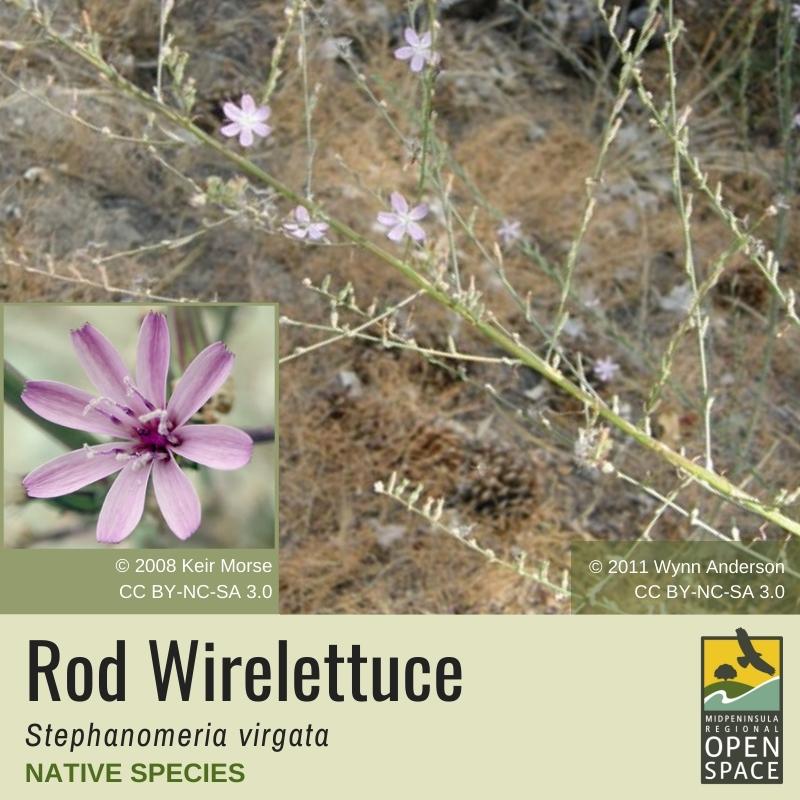
- An annual herb in the sunflower family (Asteraceae) native to California
- Found throughout dry, open habitats in Oregon, California, Nevada and northern Mexico
- Grows 2 to 12 inches tall with long hairless or woolly stems with dense branches
- Blooms from July to October with white to dark pink flowers
- A variety of beneficial insects are attracted to the flowers, especially native bees
- Often characteristic of disturbed places like roadsides, croplands, rangelands and vacant lots
Nonnative - Skeleton Weed (Chondrilla juncea)
Image
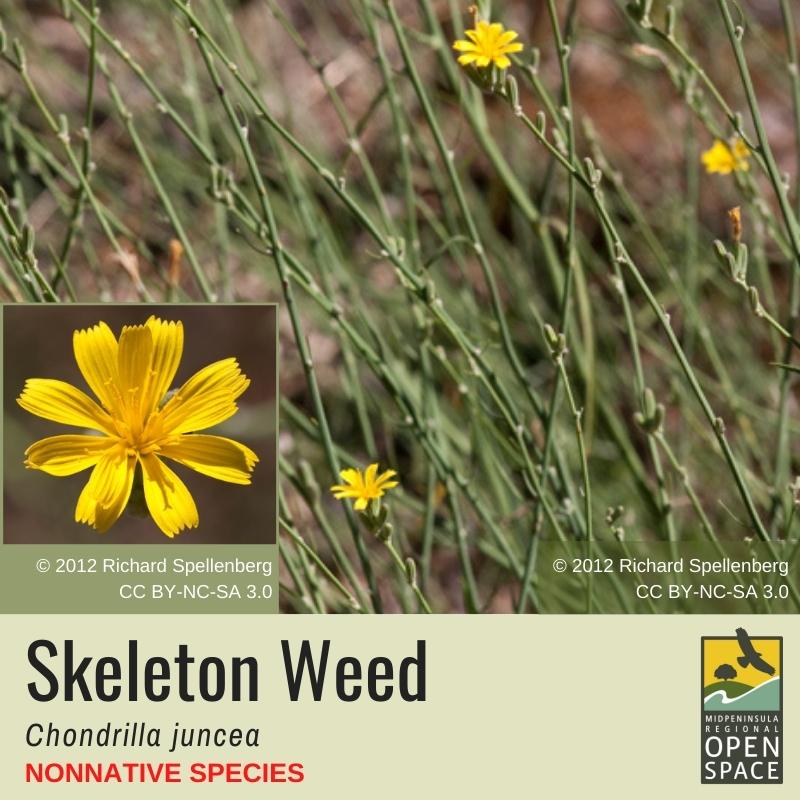
- Invasive, nonnative, perennial or biennial herb from southern Europe and Eurasia
- Grows up to 40 inches tall with stems that have short downward-pointing hairs and rosette leaves at the base
- Blooms from July to October with yellow flowers
- Taproots can penetrate to depths of six to ten feet and the plant can resprout from small root fragments in as much as three feet of soil
- Out-competes native plant species for water and nutrients, particularly in grasslands
- Tough, woody flower stems can hinder harvest machinery in grain and hay fields
Native - California Coffeeberry (Frangula californica)
Image
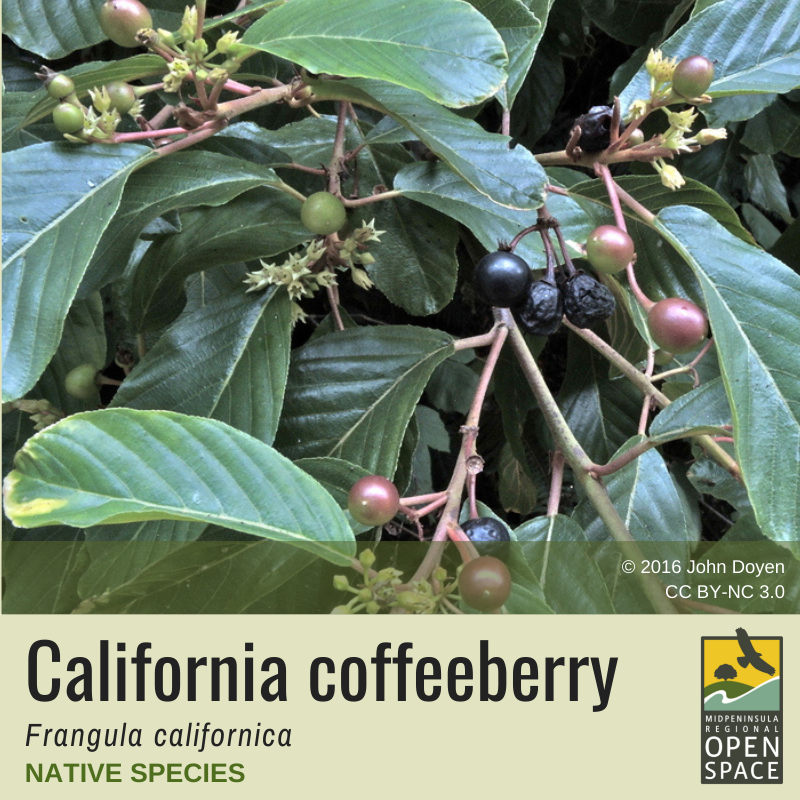
- A native evergreen shrub distributed throughout most of California. Also known as California buckthorn.
- Habitat: open woodland, brush, canyon sides and chaparral. Often used for erosion control.
- Grows up to 15 feet tall with reddish stems and leaves that appear shiny and dark in the shade but lighter and gray-green in the sunlight.
- Blooms from June to August. The flowers are small and greenish-white with five petals; they are produced in clusters of 5-60.
- Berries look like coffee beans and are red, purple, or black/brown in color.
- Attracts wildlife such as native birds, bees, butterflies, and small mammals.
Non-native - Italian Buckthorn (Rhamnus alaternus)
Image
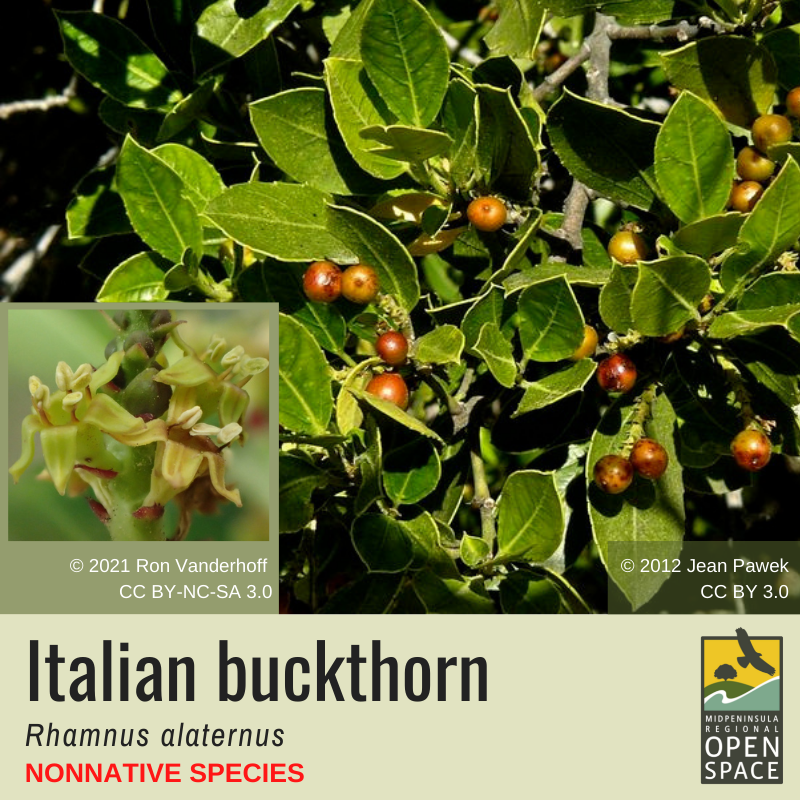
- A non-native evergreen shrub from the Mediterranean. It can be found in the Bay Area as well as the central and south coast ranges of California.
- Habitat: Coastal regions, riparian, grassland, forest margins, rocky outcrops.
- Grows up to 15 feet tall with reddish-brown bark. The oval-shaped, alternate leaves are leathery, glossy, and toothed around the edges.
- Italian buckthorn blooms from February to April. Flowers are inconspicuous, yellow-green clusters.
- According to Cal-IPC (California Invasive Plant Council) this plant has a high risk of becoming invasive in California.
Native - Common verbena (Verbena lasiostachys)
Image
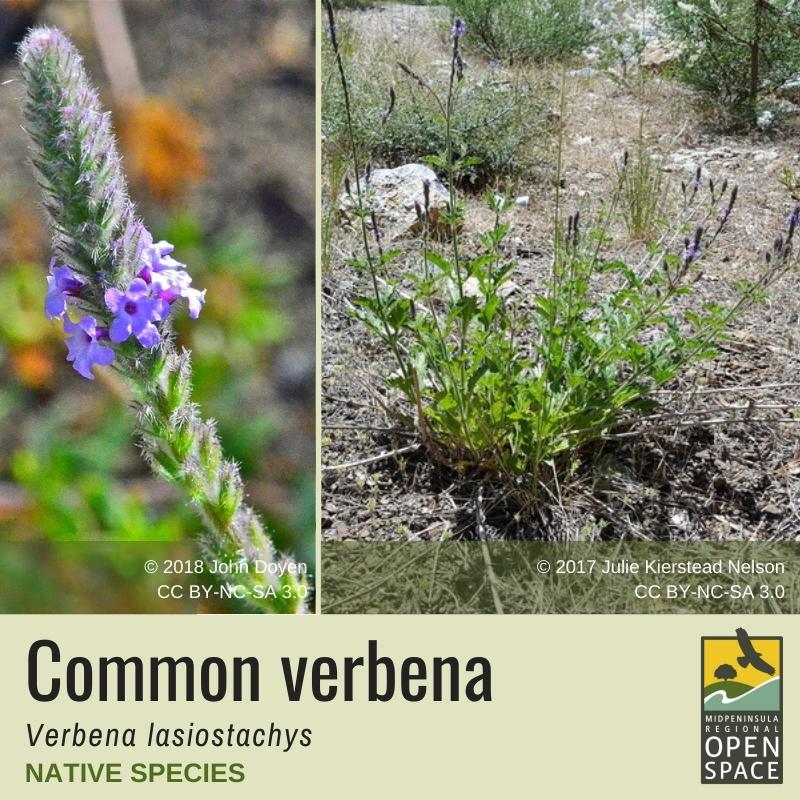
- Perennial forb (herb) that grows in California and Oregon
- Grows up to 3 feet tall with 3 to 10 inch-long cylindrical purple flower spikes that bloom April to September
- With a long blooming season, it attracts many species of butterflies, including the California Dogface and Mournful Duskywing
- A pioneer species and an aggressive spreader, it is a common native species (and you can find it throughout Midpen preserves)
Non-native - Purpletop vervain (Verbena bonariensis)
Image

- Non-native, annual or biennial forb (herb) from South America that has a high risk of becoming invasive in California
- Grows 3 to 6 feet tall and blooms with clumps of lilac, lavender or purple flowers from May to June
- Tends to favor grassland, riparian and bottomland habitat
- Readily self-seeds and seeds are dispersed by animals, wind and water
Native - Meadow barley (Hordeum brachyantherum)
Image
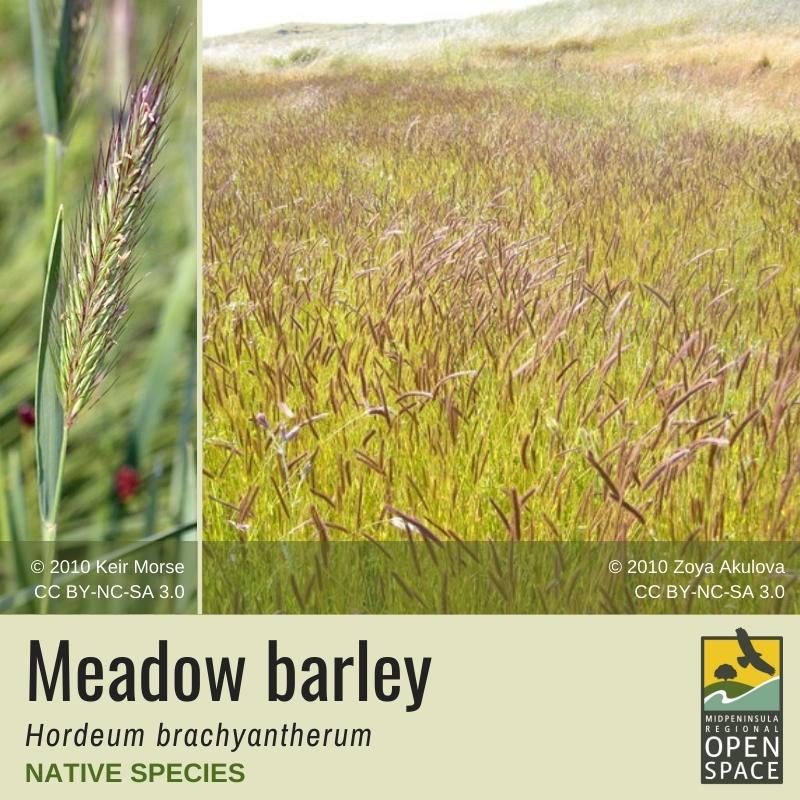
- Perennial bunchgrass native to North America and eastern Russia
- Grows to 2-3 feet tall with narrow purplish flower clusters that bloom from June to July
- Supports deer and other hooved animals in spring and pollinators, like butterflies and moths, in summer
- Often planted for soil stabilization due to high seedling vigor, wide soil tolerances and rapid development
Non-native - Jointed goatgrass (Aegilops cylindrica)
Image
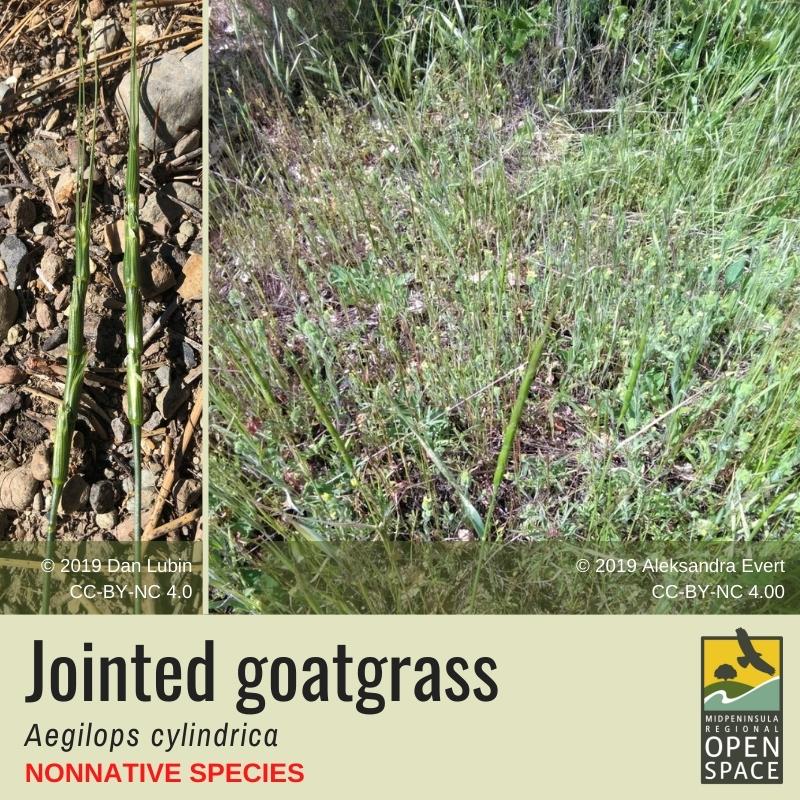
- Non-native, annual grass from western Asia and eastern Europe that has a high risk of becoming invasive in California
- Grows 1 to 2.5 feet tall and blooms from May to July
- Found primarily in wheat fields and other cropland, as well as along roadways and railroad tracks
- Each plant can produce around 3,000 seeds that remain viable for 3-5 years
Image
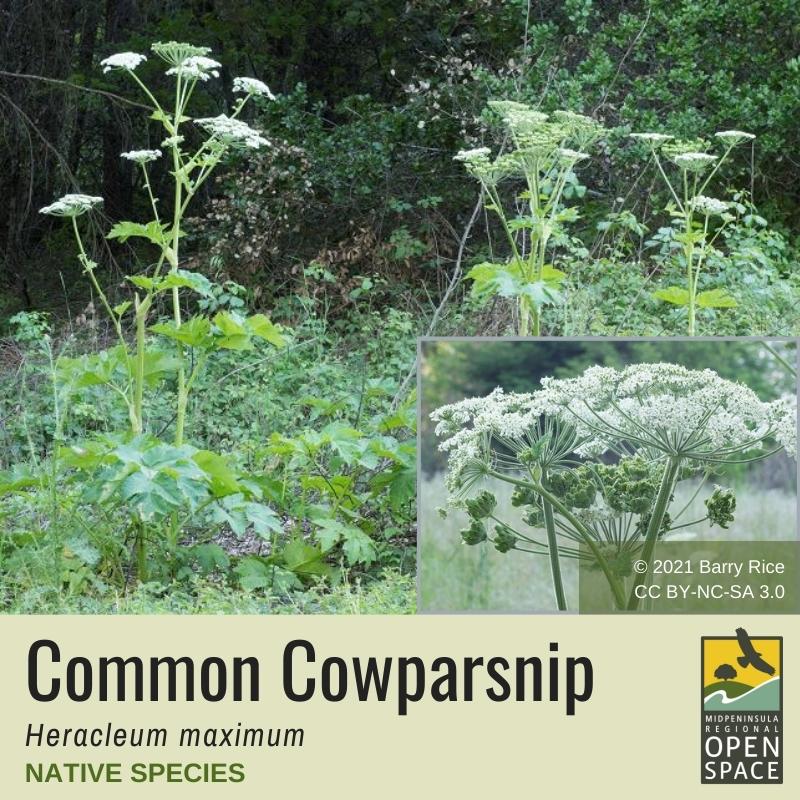
Native - Common Cowparsnip (Heracleum maximum)
- Perennial forb (herb) native to North America
- The largest member of the carrot family in North America, it can grow up to 10 feet tall.
- Has large, serrated, palmate green leaves that can get up to 18 inches across
- Tiny creamy-white flowers bloom from June to July in lacy flat-topped clusters up to 12 inches in diameter.
- Eaten by deer, elk, moose and livestock, it is also a larval host to anise swallowtail butterfly.
- Indigenous people in the Northwest used the hollow stems to make deer call
Image
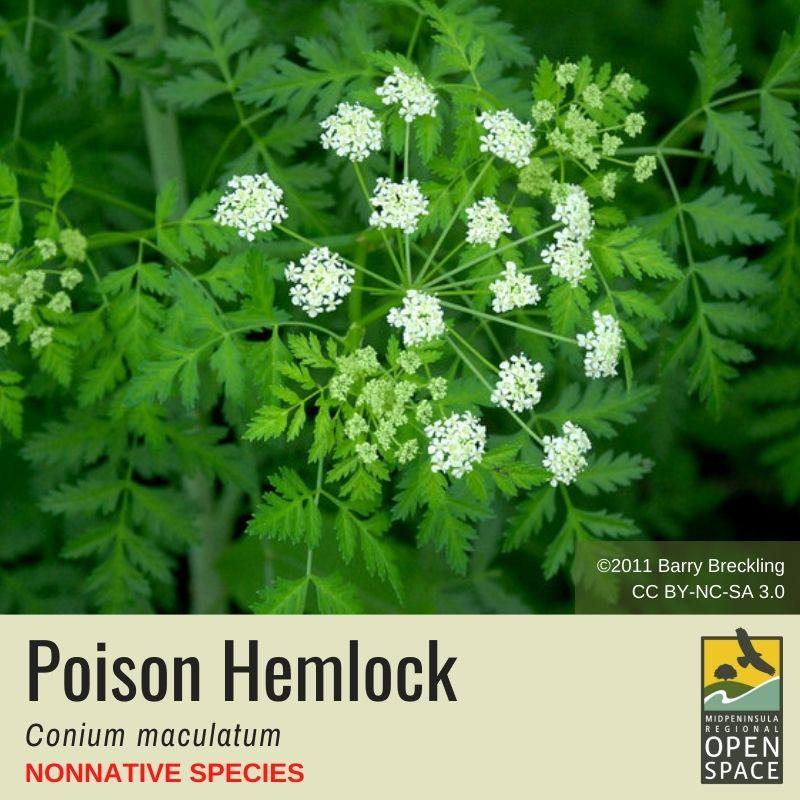
Non-native - Poison Hemlock (Conium maculatum)
- Non-native, invasive perennial forb (herb) from Europe that was introduced in the 1800s as an ornamental winter fern
- Growing 6-10 feet tall, they easily oversahade native plant communities and outcompete them.
- A member of the carrot family, it has bright green, fern-like, finely divided leaves.
- A biennial, the plant blooms every other year from April to September with tiny, white flowers arranged in small, umbrella-shaped clusters.
- As suggested by the name, all parts of the plant are acutely toxic to people and animals with symptoms appearing 20 minutes to three hours after ingestion. It is also toxic to skin and respiratory system as well.
Native - Poison oak (Toxicodendron diversilobum)
Image
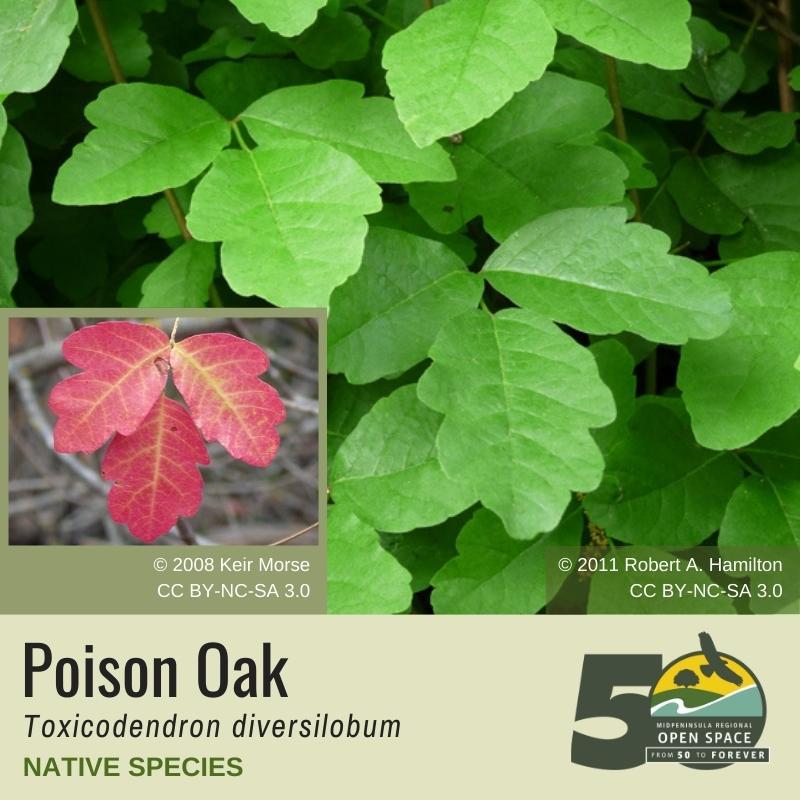
- A deciduous native vine or shrub
- Found in clearings, forest and fields on ground, climbing and/or hanging down from trees
- Woody stems with a pinkish shade grow from a foot high and many feet long, which are bare in winter
- Sprout clusters of three lobed shiny/oily leaves, which are green spring and summer, turning orange and red in autumn
- Blooms March through June with clusters of white/green flowers that fruit with velvety white berries called drupes
- Leaves of three, let it be! Every part of this plant is coated in a oily poison and allergen called “Urushiol” (pronounced “yoo-ROO-she-ol”) at all times of the year. Urushiol oil can stay active on dead plants, clothing or objects for up to 5 years and causes contact dermatitis, which may include localized irritation from a rash, itching, burning skin, swelling and/or blistering, in most people.
Nonnative - English Ivy (Hedera helix)
Image
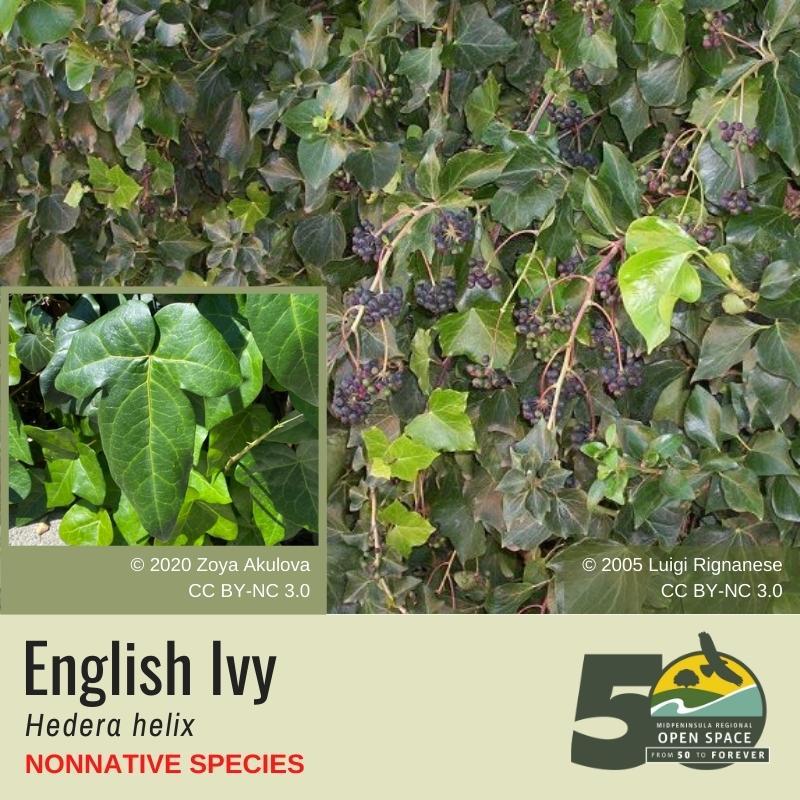
- Invasive, nonnative, evergreen vine or shrub from the British Isles, northern Europe west to the Caucasus Mountains and Mediterranean region that was introduced as an ornamental planting by early European colonists
- It has also been planted historically to control soil erosion in many parts of the US
- Found in many habitats
- Vines grow with deep-green, glossy, leathery leaves that tend to have lighter-colored veins and three to five lobes, whereas shrub leaves tend to be more ovate than lobed.
- Shrubs produce clusters of white flowers in the fall and dark blue or purple drupes in the winter; whereas vines do not flower or fruit
- Alters natural succession patterns in forests by inhibiting regeneration of native understory plants, including wildflowers, shrubs and trees and, as a result, replaces species that native wildlife rely on
- Both berries and leaves are toxic, and the plant's sap can cause dermatitis in some people

